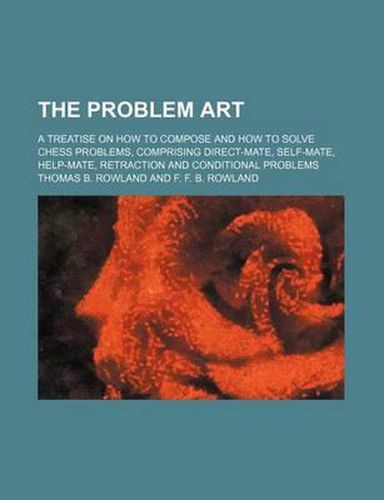The Problem Art; A Treatise on How to Compose and How to Solve Chess Problems, Comprising Direct-Mate, Self-Mate, Help-Mate, Retraction and Conditional Problems
Thomas B Rowland

The Problem Art; A Treatise on How to Compose and How to Solve Chess Problems, Comprising Direct-Mate, Self-Mate, Help-Mate, Retraction and Conditional Problems
Thomas B Rowland
This historic book may have numerous typos and missing text. Purchasers can download a free scanned copy of the original book (without typos) from the publisher. Not indexed. Not illustrated. 1887 Excerpt: …position, with the hope of constructing a problem; but the result is nil if the idea is wanting. Such a course acts as a discouragement to their efforts, and deters many from pursuing the art. They commence working in an uncertain groove, like Sir Walter Scott’s Last Minstrel
Amid the strings his fingers strayed, And an uncertain warbling made, And oft he shook his hoary head. It may happen than when engaged toying with the chessmen an idea flashes across the composer’s mind, then– When he caught the measure wild, The old man raised his face and smiled; And lightened np his faded eye With all a poet’s ecstasy. Ideas may be formed by observation–trying experiments with the pieces, solving the problems of others, playing actual games, or watching others playing. They may also be formed without observation–some pretty mate, or series of mates, ingenious sacrifice, subtle coup, or deep stratagem, may enter the composer’s mind without being sought for. Again, a composer may think out a theme, or select a piece or Pawn, and arrange a position so as to enable it to effect as many different mates as it has power to give, moving from one particular square. Effecting mate by discovery is a theme much in vogue of late. A White K, standing before a Q, E, or B, can give discovered mate by moving to one of six different squares. The squares may be covered or guarded by Black’s men; but a position can be so arranged that when Black is to play, he is forced to remove one of his guards, and so allow WK to play. The following is an illustration: –White–K at QB6, Q at QKt sq, Es at KB3, and KE4, B at KE8, Ps at QE2, K3, and KKt2. Total, 8. Black–K at K5, Bs at EB sq, and KKt5, Ets at QE sq, and KEt6, Ps at QE3, 5, and 6, Q6, KE3, and 4…
This item is not currently in-stock. It can be ordered online and is expected to ship in approx 4 weeks
Our stock data is updated periodically, and availability may change throughout the day for in-demand items. Please call the relevant shop for the most current stock information. Prices are subject to change without notice.
Sign in or become a Readings Member to add this title to a wishlist.

